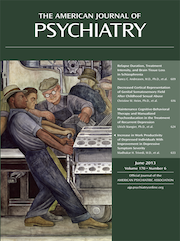Response to Barglow Letter
To the Editor: Dr. Barglow’s commentary on the Freedman et al. editorial (1) regarding publication of the DSM-5 field trial results (2) addresses the distinction between the validity and the reliability of mental disorder diagnoses now contained in the DSM-5 revision. Dr. Barglow is correct in noting the additional requirements for validity in the Robins and Guze criteria, which include distinct boundaries, family history, laboratory tests, and clinical course, modified by Kendler to include treatment response (3). However, the original Kraepelinian and the Robins and Guze neo-Kraepelinian conceptualization of categorical diagnoses with distinct boundaries between disorders has been called into question by the failure to find “zones of rarity” between diagnoses based on symptomatic overlap and epidemiologic findings in the historic paper of Kendell and Jablensky (4). More recently, the molecular genetic findings of the Cross-Disorder Group of the Psychiatric Genomics Consortium (5) put to rest the distinct genetic vulnerability theory for many mental disorders by showing common genetic vulnerabilities for neurodevelopmental disorders (autism spectrum disorder and attention deficit hyperactivity disorder), schizophrenia, bipolar disorder, and major depressive disorder—the first four chapters of DSM-5. Even Kraepelin in his later years dropped the concept of a strict separation of schizophrenia and the affective psychoses in favor of a spectrum approach that would include schizotypal personality disorder, schizophrenia, schizoaffective disorder, and bipolar disorder in today’s classification (6).
So how should we interpret the comorbidity of posttraumatic stress disorder (PTSD), major depressive disorder, generalized anxiety disorder, mild traumatic brain injury, and alcohol use disorder identified in the DSM-5 field trials—with the highest reliability among those disorders for PTSD? In the routine clinical practice field trial settings, clinicians identified a spectrum of related disorders that may well have common genetic and environmental exposure vulnerabilities, but with a central tendency for PTSD to be the dominant clinical presentation in Veterans Affairs health care settings. Given the heterogeneity of PTSD with or without one or more of these comorbid presentations, the clinical course and response to treatment may well be “moderated” by these comorbidities (7). In this regard, the Institute of Medicine study notwithstanding, and as attested by several clinical practice guidelines (8), the PTSD diagnosis does predict a favorable response to a number of treatments, in addition to prolonged exposure therapy. Finally, brain imaging and other laboratory tests are emerging to add to the list of potential moderators that will predict differential response to treatment, but we have not yet reached a point where a biomarker will qualify as a diagnostic criterion for PTSD or any other DSM-5 disorder.
1 : The initial field trials of DSM-5: new blooms and old thorns. Am J Psychiatry 2013; 170:1–5Link, Google Scholar
2 : DSM-5 field trials in the United States and Canada, part II: test-retest reliability of selected categorical diagnoses. Am J Psychiatry 2013; 170:59–70Link, Google Scholar
3 : Establishment of diagnostic validity in psychiatric illness: its application to schizophrenia. Am J Psychiatry 1970; 126:983–987Link, Google Scholar
4 : Distinguishing between the validity and utility of psychiatric diagnoses. Am J Psychiatry 2003; 160:4–12Link, Google Scholar
5
6 : Patterns of mental disorder (1920), in Themes and Variations in European Psychiatry. Edited by Hirsch SRShepherd M. Charlottesville, University Press of Virginia, 1974, pp 7–30Google Scholar
7 : A novel approach for developing and interpreting treatment moderator profiles in randomized clinical trials. JAMA Psychiatry (in press)Google Scholar
8 : A guide to guidelines for the treatment of PTSD and related conditions. J Trauma Stress 2010; 23:537–552Crossref, Medline, Google Scholar



